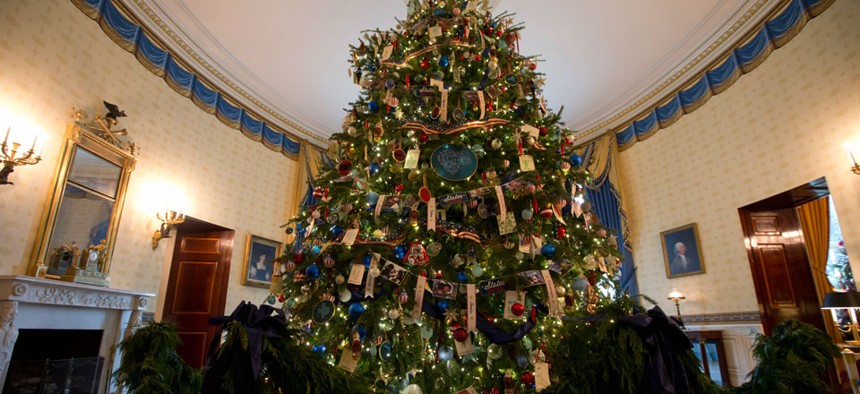
The ornament laden White House Christmas tree is seen in the Blue Room of the White House in Washington, Wednesday, Dec. 4, 2013. Jacquelyn Martin/AP
Yes, the Search for the White House Christmas Tree Has Already Begun
Tree growers descend on southwest Michigan this week to choose which farm will provide the White House with its Christmas tree.
It's Christmas in July, sort of.
While the White House Christmas Tree doesn't arrive in Washington until late November, tree farmers meet Friday in southwest Michigan to decide who among them gets to provide the tree that will sit in the Blue Room. For Christmas tree farmers, this contest is the pinnacle of their profession.
Growing trees is more than putting saplings in the ground and waiting years for it to grow. Tree farmers describe their profession like a Hollywood movie where a character must defuse a bomb: Does he snip the green wire or the red wire? Every decision to trim a stem or snip a needle could mean the difference between a losing or winning tree.
"Trees don't just look that way naturally," says Rick Dungey, the executive director of the National Christmas Tree Association. "They go through this tree meticulously, branch by branch by branch. They snip off individual needles. Lord knows how many needles there are on an 8-foot-tall tree—probably thousands of them. And they go one at a time. When you see that, you realize what it takes to win this contest."
That contest will bring the 14 best tree growers from around the country together to showcase their best 6-to-8-foot trees, their fates in the hands of six industry professional judges and dozens of local consumers who rate on everything from shape and color to form and fullness. Growers must trim and shape trees, yes, but the tree must look natural and not look like it's been trimmed and shaped.
Peterson's Riverview Nursery in Allegan, Mich., will be transformed from a quiet farm into a fluttering foliage fair. Before the winner is announced on Saturday morning, the 400 tree growers attending the convention use the time to talk trade and attempt to answer the difficult Christmas tree political questions of the day.
"Could a pine ever win the contest? Could a spruce ever win the contest?" asks Marsha Gray, the executive director of the Michigan Christmas Tree Association. "Those are things we actually talk about!"
The state tree of Michigan is the white pine, but don't expect any favoritism toward that conifer. These days, consumers lean more toward the Fraser fir and the Noble fir. Fifty years ago, Scots pine and Douglas fir ran the gamut. But last year, it was a Douglas fir from Pennsylvania that won. Industry favorites be damned, a blue spruce might even win.
In the end, however, judging trees is a subjective process. "You could line up 100 people and ask what is the best kind of Christmas tree," Dungey says. "And you're going to get 100 different answers." When the White House representative eventually picks the much larger tree from the winning farm, they will choose the one they like best.
There are 14,000 Christmas tree farms in the United States, and only one is selected for the White House. Such high stakes sometimes require extreme actions. Gray notes what her friend, a Washington state grower, had to go through several years ago. The national competition was being held in eastern Pennsylvania, but he could only fly the tree out to New York City in a refrigerated package. He borrowed someone's truck, left Pennsylvania late that night, picked up the tree at 3 a.m., made it back in time to enter the tree into the competition at 7 a.m., and ended up winning.
"He went through so much to get his tree there," Gray said. "But his tree won and he got to go to the White House."
It's one of the most iconic sights of the holidays in Washington since the tradition started in 1966: A horse-drawn carriage pulls up in front of the White House with the giant tree, greeted by the first lady. For one grower, that's their tree. It's the kind of early Christmas present any tree farmer would want.






